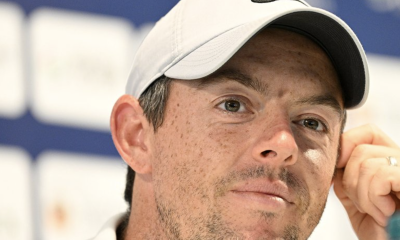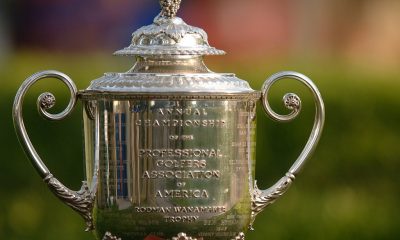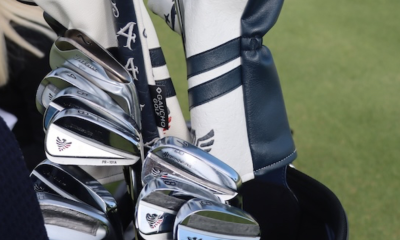Opinion & Analysis
Why golf coaching works

When I started in the golf business, I knew that I wanted to teach the game. In order to do it at a high level, I shadowed some of the best instructors in golf. This was tremendously beneficial, as I learned that I needed to develop a philosophy that fit me and that I believed in. What made each instructor great was their ability to communicate with the student, and they did so in a clear and concise manner. Each also communicated a clear philosophy in which they deeply believed in.
However, what was always a bit troubling to me was the fact each and every lesson I witnessed took place on the driving range and not on the golf course where the game is played. Every lesson took place on the range, and most were based on what the student thought they needed to work on to get better. While this produced a lot of great looking golf swings, it did not always translate to lower scores, and we ALL ultimately want to shoot lower scores.
With the understanding that our ultimate goal is to shoot lower scores and enjoy the game more, I knew that I needed to teach on the golf course. This was paramount in order to learn exactly how my students played the game of golf. Getting on the golf course allowed me to take a true assessment of their game and learn their strengths and weaknesses. It allowed me to give the student what they actually need to succeed, instead of simply giving them what they thought they needed.
In 2017, I heard a podcast featuring Will Robins who was talking about the same concept and making the distinction between coaching and instruction. I believed in what he was talking about, and what separated a coach from a traditional instructor. It is exactly what I thought all along. I joined Will’s consulting group in 2017, and started to better implement what it meant to be a coach. With Will’s guidance the results I was able to achieve by fully committing to the Coaching Model speak for themselves. Coaching clearly works at all levels, let me tell you why.
It gives the student what they need, not what they want
Traditional golf instruction became so heavily focused on “customer service” and giving the student what they wanted, that it lost sight of the overall result. In order to achieve those great results, I believe in giving my students what they need. A perfect example of this is a personal trainer. Let’s say you have a wedding to go to in 2 months and you need to lose 10 lbs. That trainer is going to get you up early, make you stick to eating healthy, and make you sore after every workout to achieve the desired result. Then at the wedding, you love your personal trainer because you look and feel great. However, if that same trainer lets you dictate what you will eat, what you’ll work on during workouts, and when you’ll come back next, the trainer will fail miserably. In other words he is paid to give you what you NEED, to get you the result you want.
Assess your game on course in a team environment
In order to give my students what they need I must learn about how they play the game. Are they anxious on the first tee? Do they get mad at things they can’t control? Do they think their driver is awful, but had 44 putts? Instead of relying on guessing, I can create a game plan through the on course assessment. I like to do this in a team environment for a few reasons. It helps me simulate pressure and many times students will learn as much from each other as they do from me. It is a win-win for everyone.
Create an improvement plan and define your goals
Based on the game assessment I set up an improvement plan for each student. This allows us to set measurable goals. An example that Will Robins uses is 10 shots in 10 weeks. The goal could be anything really, most importantly it is specific to that student. I always like to set a goal based on score because that is ultimately what we want. Lower scores to make the game more enjoyable. The improvement plan gives us a common goal, it allows me to hold my players accountable, and also allows me to do whatever it takes to get them there. It also allows my players to hold me accountable to achieving their goal, creating a true partnership
Develop your mindset
As an instructor it is easy to stand on a range and tell someone what they are doing wrong. It is easy to say I know it all, because I’m the Pro. However, it is vital I get on the course and play golf with my students. I want them to see me be vulnerable, because I want them to understand like Bob Rotella said, “Golf Is Not a Game of Perfect.” We need to stop searching for the perfect golf swing. News Flash: Nobody Has It!! In other words we need to re-train our mindset, and learn that it is often what we do after a poor shot to recover that really helps us score better.
Map your plan, apply to your game and track performance
So often I see golfers trying to be perfect but they don’t know the REAL stats. All of my students know that PGA Tour players make 99 percent of putts from 3 feet, but they fail to understand that those same PGA Tour players only make 55 percent from 6 feet. Go back to 10 feet and it drops to 35 percent. Yet time and again I see my students extremely upset after missing a 20 foot putt. The reality is most golfers are more likely to three putt from 20 feet than to make the putt. So I teach my students to simplify the game. I show them how to never make double bogey again by keeping the ball in play, and developing a great short game. When my students start to realize that the real game of golf means getting the ball holed in less shots, it changes their mindset. We use a specific scorecard to track stats that REALLY matter on the golf course and to track performance over time.
Tailor your plan through purposeful practice
When is the last time your instructor showed you exactly how to practice? Coaching is a mix of on course playing sessions and off course purposeful practice sessions. This allows me as coach the time to work on exactly what is wrong my students game. It could be anything, but most importantly it will be exactly what they need based on the playing session. Even more importantly we do both drills and tests to track progress on our practice scorecard. This allows the student to become less dependent on the instructor, and more independent, because they know what they need to do to improve each week.
Golf coaching works because it is focused on all aspects of the game, not simply technique. It teaches the golfer how to score, and how to do so under pressure in a team environment. It is results based rather than creating a “perfect golf swing.” The concept is simple in nature, but is harder to execute and stay accountable to. For these reasons, I’d challenge you to seek out a golf coach rather than a traditional instructor for your next series of lessons.
- LIKE129
- LEGIT20
- WOW7
- LOL1
- IDHT1
- FLOP4
- OB3
- SHANK10
19th Hole
Vincenzi’s 2024 PGA Championship betting preview: Rising star ready to join the immortals at Valhalla

The second major of the 2024 season is upon us as the world’s best players will tee it up this week at Valhalla Golf Club in Louisville, Kentucky to compete for the Wanamaker Trophy.
The last time we saw Valhalla host a major championship, Rory McIlroy fended off Phil Mickelson, Henrik Stenson, Rickie Fowler and the creeping darkness that was descending upon the golf course. The Northern Irishman had the golf world in the palm of his hand, joining only Tiger Woods and Jack Nicklaus as players who’d won four major championships by the time they were 25 years old.
Valhalla is named after the great hall described in Norse mythology where the souls of Vikings feasted and celebrated with the Gods. The course is a Jack Nicklaus-design that has ranked among Golf Digest’s “America’s 100 Greatest Courses” for three decades.
Valhalla Golf Club is a par-71 measuring 7,542 yards with Zoysia fairways and Bentgrass greens. The course has rolling hills and dangerous streams scattered throughout and the signature 13th hole is picturesque with limestone and unique bunkering protecting the green. The 2024 PGA Championship will mark the fourth time Valhalla has hosted the event.
The field this week will consist of 156 players, including 16 PGA Champions and 33 Major Champions.
Past Winners of the PGA Championship
- 2023: Brooks Koepka (-9) Oak Hill
- 2022: Justin Thomas (-5) Southern Hills
- 2021: Phil Mickelson (-6) Kiawah Island
- 2020: Collin Morikawa (-13) TPC Harding Park
- 2019: Brooks Koepka (-8) Bethpage Black
- 2018: Brooks Koepka (-16) Bellerive
- 2017: Justin Thomas (-8) Quail Hollow
- 2016: Jimmy Walker (-14) Baltusrol
- 2015: Jason Day (-20) Whistling Straits
- 2014: Rory McIlroy (-16) Valhalla
In this article and going forward, I’ll be using the Rabbit Hole by Betsperts Golf data engine to develop my custom model. If you want to build your own model or check out all of the detailed stats, you can sign up using promo code: MATTVIN for 25% off any subscription package (yearly is best value).
Key Stats For Valhalla
Let’s take a look at five key metrics for Oak Hill to determine which golfers boast top marks in each category over their past 24 rounds.
1. Strokes Gained: Approach
Valhalla will play as a true all-around test of golf for the world’s best. Of course, it will take strong approach play to win a major championship.
Strokes Gained: Approach Over Past 24 Rounds
- Shane Lowry (+1.25)
- Scottie Scheffler (+1.09)
- Jordan Smith (+1.05)
- Tom Hoge (+.96)
- Corey Conners (+.94)
2. Strokes Gained: Off the Tee
Valhalla will play long and the rough will be penal. Players who are incredibly short off the tee and/or have a hard time hitting fairways will be all but eliminated from contention this week at the PGA Championship.
Strokes Gained: Off the Tee Over Past 24 Rounds:
- Bryson DeChambeau (+1.47)
- Scottie Scheffler (+1.11)
- Keith Mitchell (+.90)
- Alejandro Tosti (+.89)
- Ludvig Aberg (+.82)
Strokes Gained: Total on Nickalus Designs
Valhalla is a classic Nicklaus Design. Players who play well at Nicklaus designs should have an advantage coming into this major championship.
Strokes Gained: Total on Nicklaus Designs over past 36 rounds:
- Jon Rahm (+2.56)
- Scottie Scheffler (+2.48)
- Patrick Cantlay (+2.35)
- Collin Morikawa (+1.79)
- Shane Lowry (+1.57)
Strokes Gained: Tee to Green on Very Long Courses
Valhalla is going to play extremely long this week. Players who have had success playing very long golf courses should be better equipped to handle the conditions of this major championship.
Strokes Gained: Total on Very Long Courses Over Past 24 Rounds:
- Scottie Scheffler (+2.44)
- Rory McIlroy (+2.24)
- Will Zalatoris (+1.78)
- Viktor Hovland (+1.69)
- Xander Schauffele (+1.60)
Strokes Gained: Total in Major Championships
One factor that tends to play a large role in deciding major championships is which players have played well in previous majors leading up to the event.
Strokes Gained: Total in Major Championships over past 20 rounds:
- Scottie Scheffler (+3.14)
- Will Zalatoris (+2.64)
- Rory McIlroy (+2.49)
- Xander Schauffele (+2.48)
- Tommy Fleetwood (2.09)
Strokes Gained: Putting on Bentgrass Greens
Valhalla features pure Bentgrass putting surfaces. Players who are comfortable putting on this surface will have an advantage on the greens.
Strokes Gained: Putting on Bentgrass Greens over Past 24 Rounds:
- Ludvig Aberg (+1.12)
- Denny McCarthy (+1.08)
- Matt Fitzpatrick (+0.99)
- Justin Rose (+0.93)
- J.T. Poston (0.87)
Strokes Gained: Total on Zoysia Fairways
Valhalla features Zoysia fairways. Players who are comfortable playing on this surface will have an advantage on the field.
Strokes Gained: Total on Zoysia Fairways over past 36 rounds:
- Justin Thomas (+1.53)
- Will Zalatoris (+1.47)
- Xander Schauffele (+1.40)
- Brooks Koepka (+1.35)
- Rory McIlroy (+1.23)
2024 PGA Championship Model Rankings
Below, I’ve compiled overall model rankings using a combination of the key statistical categories previously discussed — SG: Approach (25%), SG: Off the Tee (22%), SG: T2G on Very Long Courses (12%), SG: Putting on Bentgrass (+12%), SG: Total on Nicklaus Designs (12%). SG: Total on Zoysia Fairways (8%), and SG: Total in Major Championships (8%).
- Brooks Koepka
- Xander Schauffele
- Rory McIlroy
- Scottie Scheffler
- Bryson DeChambeau
- Shane Lowry
- Alex Noren
- Will Zalatoris
- Cameron Young
- Keith Mitchell
- Hideki Matsuyama
- Billy Horschel
- Patrick Cantlay
- Viktor Hovland
- Adam Schenk
- Chris Kirk
- Sahith Theegala
- Min Woo Lee
- Joaquin Niemann
- Justin Thomas
2024 PGA Championship Picks
Ludvig Aberg +1800 (BetMGM)
At The Masters, Ludvig Aberg announced to the golf world that he’s no longer an “up and coming” player. He’s one of the best players in the game of golf, regardless of experience.
Augusta National gave Aberg some necessary scar tissue and showed him what being in contention at a major championship felt like down the stretch. Unsurprisingly, he made a costly mistake, hitting it in the water left of the 11th hole, but showed his resilience by immediately bouncing back. He went on to birdie two of his next three holes and finished in solo second by three shots. With the type of demeanor that remains cool in pressure situations, I believe Ludvig has the right mental game to win a major at this point in his career.
Aberg has not finished outside of the top-25 in his past eight starts, which includes two runner-up finishes at both a “Signature Event” and a major championship. The 24-year-old is absolutely dominant with his driver, which will give him a major advantage this week. In the field he ranks, in Strokes Gained: Off the Tee, and has gained strokes in the category in each of his past ten starts. Aberg is already one of the best drivers of the golf ball on the planet.
In Norse mythology, Valhalla is the great hall where the souls of Vikings feasted and celebrated with the Gods. The Swedes, who are of Old Norse origin, were the last of the three Scandinavian Kingdoms to abandon the Old Norse Gods. A Swede played a major role in the 2014 PGA Championship at Valhalla, and I believe another, Ludvig Aberg, will be the one to conquer Valhalla in 2024.
Bryson DeChambeau +2800 (BetMGM)
Bryson DeChambeau is one of the few players in the world that I believe has the game to go blow-for-blow with Scottie Scheffler. Although he isn’t as consistent as Scheffler, when he’s at his best, Bryson has the talent to beat him.
At The Masters, DeChambeau put forth a valiant effort at a golf course that simply does not suit his game. Valhalla, on the other hand, is a course that should be perfect for the 30-year-old. His ability to overpower a golf course with his driver will be a serious weapon this week.
Bryson has had some success at Jack Nicklaus designs throughout his career as he won the Memorial at Muirfield Village back in 2018. He’s also had incredible results on Bentgrass greens for the entirety of his professional career. Of his 10 wins, nine of them have come on Bentgrass greens, with the only exception being the Arnold Palmer Invitational at Bay Hill. He also has second place finishes at Medinah and TPC Summerlin, which feature Bentgrass greens.
Love him or hate him, it’s impossible to argue that Bryson isn’t one of the most exciting and important players in the game of golf. He’s also one of the best players in the world. A second major is coming soon for DeChambeau, and I believe he should be amongst the favorites to hoist the Wanamaker Trophy this week.
Patrick Cantlay +4000 (FanDuel)
There’s no way of getting around it: Patrick Cantlay has been dissapointing in major championships throughout his professional career. He’s been one of the top players on Tour for a handful of years and has yet to truly contend at a major championship, with the arguable exception of the 2019 Masters.
Despite not winning majors, Cantlay has won some big events. The 32-year-old has won two BMW Championships, two Memorial Tournaments as well as a Tour Championship. His victories at Memorial indicate how much Cantlay loves Nicklaus designs, where he ranks 3rd in the field in Strokes Gained: Total over his past 36 rounds behind only Scottie Scheffler and Jon Rahm.
Cantlay also loves Bentgrass greens. Six of Cantlay’s seven individual wins on the PGA Tour have come on Bentgrass greens and he also was one of the best putters at the 2023 Ryder cup at Marco Simone (also Bentgrass). At Caves Valley (2021 BMW Championship), he gained over 12 strokes putting to outduel another Bentgrass specialist, Bryson DeChambeau.
Cantlay finished 22nd in The Masters, which was a solid result considering how many elite players struggled that week. He also has two top-ten finishes in his past five PGA Championships. He’s undeniably one of the best players in the field, therefore, it comes down to believing Cantlay has the mental fortitude to win a major, which I do.
Joaquin Niemann +4000 (BetMGM)
I believe Joaquin Niemann is one of the best players in the world. He has three worldwide wins since December and has continued to improve over the course of his impressive career thus far. Still only 25, the Chilean has all the tools to be a serious contender in major championships for years to come.
Niemann has been the best player on LIV this season. Plenty will argue with the format or source of the money on LIV, but no one can argue that beating players such as Jon Rahm, Bryson DeChambeau, Dustin Johnson, Brooks Koepka and Cameron Smith is an unremarkable achievement. Niemann is an elite driver of the golf ball who hits it farther than just about anyone in the field not named Bryson DeChambeau or (arguably) Rory McIlroy.
Niemann is another player who has been fantastic throughout his career on Bentgrass greens. Prior to leaving the PGA Tour, Bentgrass was the only green surface in which Joaco was a positive putter. It’s clearly a surface that he is very comfortable putting on and should fare around and on the greens this week.
Niemann is a perfect fit for Valhalla. His low and penetrating ball flight will get him plenty of runout this week on the fairways and he should have shorter shots into the green complexes than his competitors. To this point in his career, the former top ranked amateur in the world (2018) has been underwhelming in major championships, but I don’t believe that will last much longer. Joaquin Niemann is a major championship caliber player and has a real chance to contend this week at Valhalla.
- LIKE37
- LEGIT15
- WOW4
- LOL1
- IDHT1
- FLOP4
- OB3
- SHANK17
Opinion & Analysis
The Wedge Guy: What really makes a wedge work? Part 2

In my last post, I explained the basic performance dynamics of “smash factor” and “gear effect” as they apply to your wedges and your wedge play success. If you missed that post, you can read it here.
At the end of that post, I promised “part 2” of this discussion of what makes a wedge work the way it does. So, let’s dive into the other two components of any wedge – the shaft and the grip.
It’s long been said that the shaft is “the engine of the golf club.” The shaft (and grip) are your only connection to all the technologies that are packed into the head of any golf club, whether it be a driver, fairway, hybrid, iron, wedge or even putter.
And you cannot ignore those two components of your wedges if your goal is optimizing your performance.
I’ve long been an advocate of what I call a “seamless transition” from your irons into your wedges, so that the feel and performance do not disconnect when you choose a gap wedge, for example, instead of your iron-set-matching “P-club.” In today’s golf equipment marketplace, more and more golfers are making the investment of time and money to experience an iron fitting, going through trial and error and launch monitor measuring to get just the right shaft in their irons.
But then so many of those same golfers just go into a store and choose wedges off the retail display, with no similar science involved at all. And that’s why I see so many golfers with a huge disconnect between their custom-fitted irons, often with lighter and/or softer graphite or light steel shafts . . . and their off-the-rack wedges with the stock stiff steel ‘wedge flex’ shaft common to those stock offerings.
If your wedge shafts are significantly heavier and stiffer than the shafts in your irons, it is physically impossible for you to make the same swing. Period.
To quickly improve your wedge play, one of the first things you can do is have your wedges re-shafted with the same or similar shaft that is in your irons.
There’s another side of that shaft weight equation; if you don’t have the forearm and hand strength of a PGA Tour professional, you simply cannot “handle” the same weight shaft that those guys play to master the myriad of ‘touch shots’ around the greens.
Now, let’s move on to the third and other key component of your wedges – the grips. If those are not similar in shape and feel to the grips on your irons, you have another disconnect. Have your grips checked by a qualified golf club professionals to make sure you are in sync there.
The one caveat to that advice is that I am a proponent of a reduced taper in your wedge grips – putting two to four more layers of tape under the lower hand, or selecting one of the many reduced taper grips on the market. That accomplishes two goals for your scoring.
First, it helps reduce overactive hands in your full and near-full wedge swings. Quiet hands are key to good wedge shots.
And secondly, it provides a more consistent feel of the wedge in your hands as you grip down for those shorter and more delicate shots around the greens. And you should always grip down as you get into those touch shots. I call it “getting closer to your work.”
So, if you will spend as much time selecting the shafts and grips for your wedges as you do choosing the brand, model, and loft of them, your scoring range performance will get better.
More from the Wedge Guy
- The Wedge Guy: What really makes a wedge work? Part 1
- The Wedge Guy: The easiest-to-learn golf basic
- The Wedge Guy: Golf mastery begins with your wedge game
- LIKE6
- LEGIT3
- WOW0
- LOL1
- IDHT1
- FLOP0
- OB0
- SHANK5
19th Hole
Vincenzi’s 2024 Wells Fargo Championship betting preview: Tommy Fleetwood ready to finally land maiden PGA Tour title

The PGA Tour season ramps back up this week for another “signature event,” as golf fans look forward to the year’s second major championship next week.
After two weaker-field events in the Zurich Classic and the CJ Cup Byron Nelson, most of the best players in the world will head to historic Quail Hollow for one of the best non-major tournaments of the year.
Last season, Wyndham Clark won the event by four shots.
Quail Hollow is a par-71 measuring 7,521 yards that features Bermudagrass greens. The tree-lined, parkland style course can play quite difficult and features one of the most difficult three-hole stretches in golf known as “The Green Mile,” which makes up holes 16-18: two mammoth par 4s and a 221-yard par 3. All three holes have an average score over par, and water is in play in each of the last five holes on the course.
The field is excellent this week with 68 golfers teeing it up without a cut. All of the golfers who’ve qualified are set to tee it up, with the exception of Scottie Scheffler, who is expecting the birth of his first child.
Past Winners at Quail Hollow
- 2023: Wyndham Clark (-19)
- 2022: Max Homa (-8)
- 2021: Rory McIlroy (-10)
- 2019: Max Homa (-15)
- 2018: Jason Day (-12)
- 2017: Justin Thomas (-8) (PGA Championship)
- 2016: James Hahn (-9)
- 2015: Rory McIlroy (-21)
Key Stats For Quail Hollow
Strokes Gained: Approach
Strokes gained: Approach will be extremely important this week as second shots at Quail Hollow can be very difficult.
Total SG: Approach Over Past 24 Rounds
- Akshay Bhatia (+1.16)
- Tom Hoge (+1.12)
- Corey Conners (+1.01)
- Shane Lowry (+0.93)
- Austin Eckroat (+0.82)
Strokes Gained: Off the Tee
Quail Hollow is a long course on which it is important to play from the fairway. Both distance and accuracy are important, as shorter tee shots will result in approach shots from 200 or more yards. With most of the holes heavily tree lined, errant drives will create some real trouble for the players.
Strokes Gained: Off the Tee Past 24 Rounds:
- Ludvig Aberg (+0.73)
- Rory McIlroy (+0.69)
- Xander Schauffele (+0.62)
- Viktor Hovland (+0.58)
- Chris Kirk (+0.52)
Proximity: 175-200
The 175-200 range is key at Quail Hollow. Players who can hit their long irons well will rise to the top of the leaderboard.
Proximity: 175-200+ over past 24 rounds:
- Cameron Young (28’2″)
- Akshay Bhatia (29’6″)
- Ludvig Aberg (+30’6″)
- Sam Burns (+30’6″)
- Collin Morikawa (+30’9″)
SG: Total on Tom Fazio Designs
Players who thrive on Tom Fazio designs get a bump for me at Quail Hollow this week.
SG: Total on Tom Fazio Designs over past 36 rounds:
- Patrick Cantlay (+2.10)
- Rory McIlroy (+1.95)
- Tommy Fleetwood (+1.68)
- Austin Eckroat (+1.60)
- Will Zalatoris (+1.57)
Strokes Gained: Putting (Bermudagrass)
Strokes Gained: Putting has historically graded out as the most important statistic at Quail Hollow. While it isn’t always predictable, I do want to have it in the model to bump up golfers who prefer to putt on Bermudagrass.
Strokes Gained: Putting (Bermudagrass) Over Past 24 Rounds:
- Taylor Moore (+0.82)
- Nick Dunlap (+.76)
- Wyndham Clark (+.69)
- Emiliano Grillo (+.64)
- Cam Davis (+.61)
Course History
This stat will incorporate players that have played well in the past at Quail Hollow.
Course History over past 36 rounds (per round):
- Rory McIlroy (+2.50)
- Justin Thomas (+1.96)
- Jason Day (+1.92)
- Rickie Fowler (+1.83)
- Viktor Hovland (+1.78)
Wells Fargo Championship Model Rankings
Below, I’ve compiled overall model rankings using a combination of the five key statistical categories previously discussed — SG: Approach (27%), SG: Off the Tee (23%), SG: Total on Fazio designs (12%), Proximity: 175-200 (12%), SG: Putting Bermuda grass (12%), and Course History (14%).
- Wyndham Clark
- Rory McIlroy
- Xander Schauffele
- Shane Lowry
- Hideki Matsuyama
- Viktor Hovland
- Cameron Young
- Austin Eckroat
- Byeong Hun An
- Justin Thomas
2024 Wells Fargo Championship Picks
Tommy Fleetwood +2500 (DraftKings)
I know many out there have Tommy fatigue when it comes to betting, which is completely understandable given his lack of ability to win on the PGA Tour thus far in his career. However, history has shown us that players with Fleetwood’s talent eventually break though, and I believe for Tommy, it’s just a matter of time.
Fleetwood has been excellent on Tom Fazio designs. Over his past 36 rounds, he ranks 3rd in the field in Strokes Gained: Total on Fazio tracks. He’s also been incredibly reliable off the tee this season. He’s gained strokes in the category in eight of his past nine starts, including at The Masters, the PLAYERS and the three “signature events” of the season. Tommy is a golfer built for tougher courses and can grind it out in difficult conditions.
Last year, Fleetwood was the first-round leader at this event, firing a Thursday 65. He finished the event in a tie for 5th place.
For those worried about Fleetwood’s disappointing start his last time out at Harbour Town, he’s bounced back nicely after plenty of poor outings this season. His T7 at the Valero Texas Open was after a MC and T35 in his prior two starts and his win at the Dubai Invitational came after a T47 at the Sentry.
I expect Tommy to bounce back this week and contend at Quail Hollow.
Justin Thomas +3000 (DraftKings)
It’s been a rough couple of years for Justin Thomas, but I don’t believe things are quite as bad as they seem for JT. He got caught in the bad side of the draw at Augusta for last month’s Masters and has gained strokes on approach in seven of his nine starts in 2024.
Thomas may have found something in his most recent start at the RBC Heritage. He finished T5 at a course that he isn’t the best fit for on paper. He also finally got the putter working and ranked 15th in Strokes Gained: Putting for the week.
The two-time PGA champion captured the first of his two major championships at Quail Hollow back in 2017, and some good vibes from the course may be enough to get JT out of his slump.
Thomas hasn’t won an event in just about two years. However, I still believe that will change soon as he’s been one of the most prolific winners throughout his PGA Tour career. Since 2015, he has 15 PGA Tour wins.
Course history is pretty sticky at Quail Hollow, with players who like the course playing well there on a regular basis. In addition to JT’s PGA Championship win in 2017, he went 4-1 at the 2022 Presidents Cup and finished T14 at the event last year despite being in poor form. Thomas can return as one of the top players on the PGA Tour with a win at a “signature event” this week.
Cameron Young +3500 (DraftKings)
For many golf bettors, it’s been frustrating backing Cam Young this season. His talent is undeniable, and one of the best and most consistent performers on the PGA Tour. He just hasn’t broken through with a victory yet. Quail Hollow has been a great place for elite players to get their first victory. Rory McIlroy, Anthony Kim, Rickie Fowler and Wyndham Clark all notched their first PGA Tour win at Quail.
Throughout Cam Young’s career, he has thrived at tougher courses with strong fields. This season, he finished T16 at Riviera and T9 at Augusta National, demonstrating his preference of a tough test. His ability to hit the ball long and straight off the tee make him an ideal fit for Quail Hollow, despite playing pretty poorly his first time out in 2023 (T59). Young should be comfortable playing in the region as he played his college golf at Wake Forest, which is about an hour’s drive from Quail Hollow.
The 26-year-old has played well at Tom Fazio designs in the past and ranks 8th in the field in Strokes Gained: Total on those courses in his last 36 rounds. Perhaps most importantly, this season, Young is the best player on the PGA Tour in terms of proximity from 175-200 in the fairway, which is where a plurality and many crucial shots will come from this week.
Young is an elite talent and Quail Hollow has been kind to players of his ilk who’ve yet to win on Tour.
Byeong Hun An +5000 (FanDuel)
Byeong Hun An missed some opportunities last weekend at the CJ Cup Byron Nelson. He finished T4 and played some outstanding golf, but a couple of missed short putts prevented him from getting to the winning score of -23. Despite not getting the win, it’s hard to view An’s performance as anything other than an overwhelming success. It was An’s fourth top-ten finish of the season.
Last week, An gained 6.5 strokes ball striking, which was 7th in the field. He also ranked 12th for Strokes Gained: Approach and 13th for Strokes Gained: Off the Tee. The South Korean has been hitting the ball so well from tee to green all season long and he now heads to a golf course that should reward his precision.
An’s driver and long irons are absolute weapons. At Quail Hollow, players will see plenty of approach shots from the 175-200 range as well as some from 200+. In his past 24 rounds, Ben ranks 3rd in the field in proximity from 175-200 and 12th in proximity from 200+. Playing in an event that will not end up being a “birdie” fest should help An, who can separate from the field with his strong tee to green play. The putter may not always cooperate but getting to -15 is much easier than getting to -23 for elite ball strikers who tend to struggle on the greens.
Winning a “signature event” feels like a tall task for An this week with so many elite players in the field. However, he’s finished T16 at the Genesis Invitational, T16 at The Masters and T8 at the Arnold Palmer Invitational. The 32-year-old’s game has improved drastically this season and I believe he’s ready to get the biggest win of his career.
- LIKE9
- LEGIT4
- WOW1
- LOL1
- IDHT1
- FLOP1
- OB0
- SHANK1
-

 19th Hole3 days ago
19th Hole3 days agoBrandel Chamblee says this is the primary reason why Rory McIlroy hasn’t won a major in 10 years
-

 Whats in the Bag4 days ago
Whats in the Bag4 days agoTiger Woods WITB 2024 (May)
-

 19th Hole2 weeks ago
19th Hole2 weeks agoReport: LIV star turns down PGA Championship invite due to ‘personal commitments’
-

 19th Hole2 weeks ago
19th Hole2 weeks agoGary Player claims this is what ‘completely ruined’ Tiger Woods’ career
-

 Equipment1 week ago
Equipment1 week agoDetails on Justin Thomas’ driver switch at the Wells Fargo Championship
-

 News1 day ago
News1 day agoScottie Scheffler arrested, charged, and released after traffic incident at Valhalla
-

 Whats in the Bag3 weeks ago
Whats in the Bag3 weeks agoTeam McIlowry (Rory McIlroy, Shane Lowry) winning WITBs: 2024 Zurich Classic
-

 Whats in the Bag2 weeks ago
Whats in the Bag2 weeks agoKeegan Bradley WITB 2024 (May)























John
Jan 3, 2019 at 2:02 pm
Matt is a young professional who loves to teach and his method is not only very effective but very reasonably priced. Although even excellent golfers could
benefit, he helped me shed beau-coup strokes, and I’m old enough to collect my pension. Yes, I had to put work in, but it was a blast and Matt was a riot to work with.
Patricknorm
Jan 1, 2019 at 8:20 am
My coach starts each session for a few minutes on the range watching me go through my bag. We then hit the course to play usually 3 or 4 holes , with the emphasis on strategy and then refining certain aspects. I cannot stress the importance of coaching. You can be foolish and spend wasteful dollars on the shiniest new toy, or you can spend time perfecting your swing flaws. You should be properly fit for the correct equipment, but if you’re a serious golfer, coaching is the best bang for your buck.
stan
Dec 31, 2018 at 3:19 pm
Very few golfers will benefit from this kind of teaching because very few are willing to make a commitment to training and practice. Most ‘golfers’ are immature non-athletic c r u d ….. and too stupid to learn and play well. I think this truth is obvious on this gearhead geek forum where ‘love’ is the equipment buzzword.
Bill Simpson
Dec 31, 2018 at 4:18 pm
So true and the proof is annual equipment model changes to exploit the desperation of incompetent golfers and childish golf club Lovers.
Ed LeBeau
Dec 31, 2018 at 2:07 pm
This article is titled, “Why golf coaching works”. It implies that golf coaching is something better than golf instruction. If we define golf instruction as limited to swing technique then I agree. However, there are two factors underlying this matter. First, the player may want and in fact only need to improve their technique and second few instructors are presented with players who demonstrate their technique is adequate but their scoring is deficient.
Paul Mattie
Jan 3, 2019 at 12:18 pm
Bill sucks headcovers
Paul Mattie
Dec 31, 2018 at 12:02 pm
This is the way my coach operates. Unless you do the home work you didn’t progress to the next step. He also had me on course not only where he taught but he also came to my place and spent 3 hours going over my troubles spots . This led to specific changes in club selection and course management.
Bill Simpson
Dec 31, 2018 at 4:23 pm
And how long did this teaching take, 6 months and several thousand $$$$$ ?
You could have bought a new set of golf clubs annually and feel good.
Paul Mattie
Jan 3, 2019 at 12:17 pm
Bill Simpson Go eff youself
Scott Saunders
Dec 31, 2018 at 11:51 am
Big takeaway is cost effectiveness. Most golfers considering lessons will balk at on-course fees and opt for range lessons. You’re correct that course controls are the key to lowering scoring. The answer to this would be figuring out how to evaluate each student for their on-course weaknesses so that you can coach these issues on-range or indoors.
Bill Simpson
Dec 31, 2018 at 4:20 pm
Tangible new golf clubs versus intangible golf lessons…. and the winner is…. 😛
Clark Williams
Jan 2, 2019 at 5:26 pm
One reason why Matt’s “team approach” works is that he walks with 4 players for 3-9 holes, not every week but every second or third week in a 10 week program. This reduces the individuals cost yet allows Matt to provide individual attention and learn about each player and how they actually play the game. I found it stimulating, educational, cost effective and fun. Especially good for new comers and intermediate players who want to improve and are willing to put in some time.
DS
Dec 31, 2018 at 11:40 am
My first ‘Shank’ rating. Not that what you wrote isn’t logical and the way much improvement should happen, but it’s totally unrealistic for the average golfer to afford. When instructors are charging $275+ for a 4 – 9 hole playing lesson, PLUS greens fees, your article is nothing more than a pipe dream.
Since I called out your pipe dream, here’s mine:
1) For these lesson factories (I’m looking at you, GolfTec), have a ‘pay for improvement’ arrangement. I’d pay $1k to lower my handicap by 5 strokes. And with GolfTec, they can actually monitor my effort so it’s not like I’m asking to spend 90 minutes in a bay and magically improve by 5 strokes. I’ll put in the work, they put in the expertise, and the results should happen. If they don’t, then they don’t get paid or at least they take a material cut from their fees. I got an email from GolfTec and responded with this idea. I’m sure there’s no surprise that pay for results isn’t anything they’re interested in.
2) Same hourly rates on the course as at the range. Why is Joe Pro charging $65/hr at the range but essentially $125/hr on the course? Did he suddenly get much smarter when real balls are used? I don’t think so, and this ridiculous price gouging needs to stop. Do you care about growing the game and having students get better, or is this just a way to make a fast couple of hundred bucks on your sucker student’s back?
3) Stop being so contradictory with each other. Had a great experience in NC for a 3-day school, but they started with ‘so tired of people telling me they need to keep their head down, or they want to stop swinging over the top’. I called them out on it because so many amateurs struggle with both, including me. Their response was to bring up Annika and Stenson and say with a wry smile ‘I think we’d all agree their pretty good’. To which I said – name me another one who swings like that? Crickets. Then I said Furyk is pretty good, as was (is?) Jim Thorpe – are they going to teach those swings? It’s this kind of contradictory BS that leaves amateurs confused.
No skin in the game, cost, and inconsistent approaches are big issues with how the game is taught today. If you pros don’t change your ways, don’t complain as we watch the game get less and less popular.
Matt
Jan 2, 2019 at 2:32 pm
DS,
I would love to learn more about your thoughts on how to improve golfers, adding a ‘skin in the game’ component. Hit me up with a DM in the forums. Strolf or email me [email protected]
Clark Williams
Jan 2, 2019 at 5:18 pm
Not true, I personally worked with Matt last summer, ten weeks (actually more due to rain outs) significantly less than $500(the cost of a driver). I had a severe back issue that flared up so was unable to practice effectively yet learned a lot about my game. Many at our course who worked with Matt saw significant improvement and more importantly had a better understanding of the game and therefore enjoyed their experience more.
A. Commoner
Jan 3, 2019 at 12:27 pm
absolutely love your post
Moxley
Dec 31, 2018 at 4:19 am
Interesting article.
I’ve no doubt that there is a place for your style of coaching, but I think it is better suited towards younger, elite golfers. I’m not so sure this is suited to the regular mid/high capper at the golf club who just wants to fix his slice or hit it a few yards further.
Your assertions about what golfers need starts with the assumption that success is defined as scoring better, but I think for more recreational golfers, success is simply having fun when playing with their mates. What they want is a few quick wins, something that is going to make them a little bit better without taking the fun away (i.e. clubbing down), and something to have fun working on – all of this needs to come at an affordable price, because for most, golf is just a hobby.
Serious golfers will always need serious golfers, but the objectives won’t always be the same with the average golfer.
wilbur
Dec 31, 2018 at 12:48 am
Great article but does the instructor/teacher/mentor help you pick out the best golf clubs for your game. Unless you have the best driver to best putter it’s all futile because the equipment is what counts in the final analysis.
Bill Simpson
Dec 31, 2018 at 4:24 pm
Bingo!!! The ‘best’ golf clubs will transform your swing and game overnight.
Ryan
Dec 30, 2018 at 9:34 pm
Great idea and approach, but I’m sure this type of service is not cheap.
Bill Simpson
Dec 31, 2018 at 4:26 pm
Yes, not cheap….. and neither are the ‘best’ golf clubs.
Obee
Dec 30, 2018 at 8:56 pm
Love this approach.
Tom L
Dec 30, 2018 at 6:31 pm
Sounds great but potentially pricey
Michael Deiters
Dec 30, 2018 at 2:29 pm
Good stuff. All “instruction” should look like this.
2putttom
Dec 30, 2018 at 1:32 pm
instructors I use teach on the course (when applicable) it has been beneficial and rewarding.
dj
Dec 30, 2018 at 12:26 pm
I like your idea of a metric that is measurable.